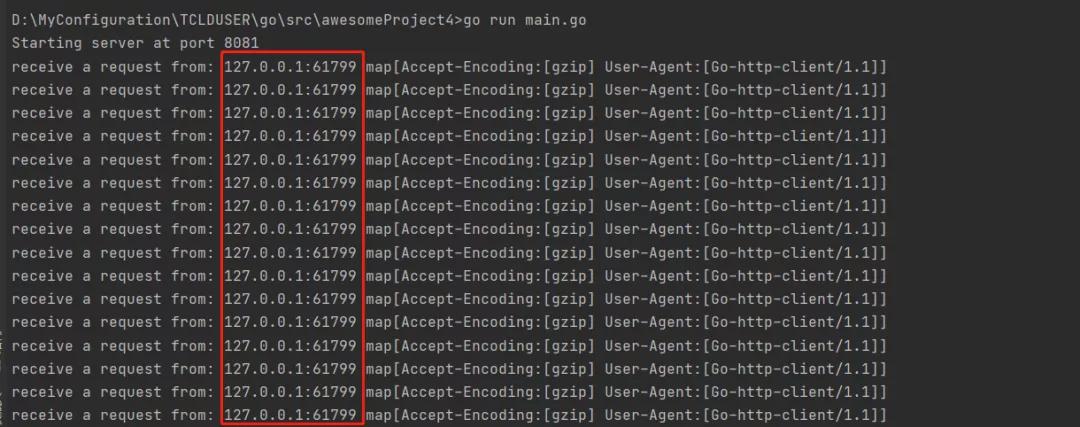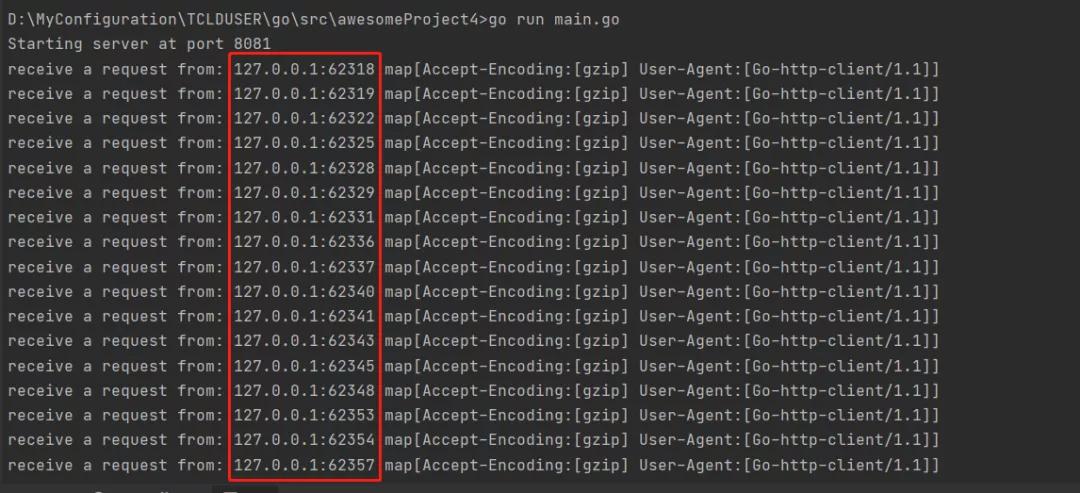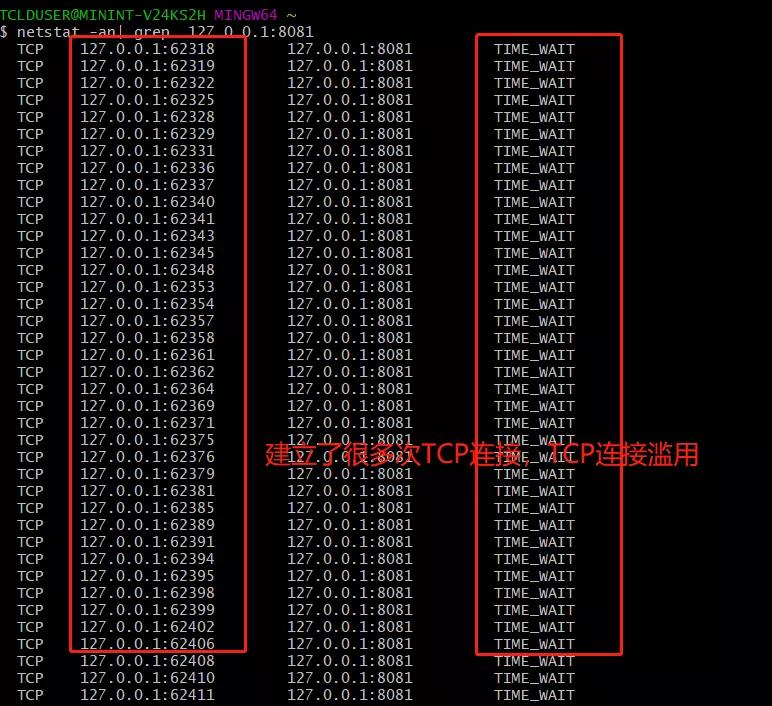有關Http持久連接的一切,卷給你看
上文中我的結論是: HTTP Keep-Alive 是在應用層對TCP連接進行滑動續約復用, 如果客戶端/服務器穩定續約,就成了名副其實的長連接。
目前所有的Http網絡庫都默認開啟了HTTP Keep-Alive,今天我們從底層TCP連接和排障角度撕碎HTTP持久連接。
“我只是一個寫web程序的猿,我為什么要知道這么多??????”。
使用go語言倒騰一個httpServer/httpClient,粗略聊一聊go的使用風格。
使用go語言net/http包快速搭建httpserver,注入用于記錄請求日志的Handler
- package main
- import (
- "fmt"
- "log"
- "net/http"
- )
- // IndexHandler記錄請求的基本信息: 請關注r.RemoteAddr
- func Index(w http.ResponseWriter, r *http.Request) {
- fmt.Println("receive a request from:", r.RemoteAddr, r.Header)
- w.Write([]byte("ok"))
- }
- // net/http 默認開啟持久連接
- func main() {
- fmt.Printf("Starting server at port 8081\n")
- if err := http.ListenAndServe(":8081", http.HandlerFunc(Index)); err != nil {
- log.Fatal(err)
- }
- }
ListenAndServe創建了默認的httpServer服務器,go通過首字母大小寫來控制訪問權限,如果首字母大寫,則可以被外部包訪問, 類比C#全局函數、靜態函數。
- func ListenAndServe(addr string, handler Handler) error {
- server := &Server{Addr: addr, Handler: handler}
- return server.ListenAndServe()
- }
net/http服務器默認開啟了Keep-Alive, 由Server的私有變量disableKeepAlives體現。
- type Server struct {
- ...
- disableKeepAlives int32 // accessed atomically.
- ...
- }
使用者也可以手動關閉Keep-Alive, SetKeepAlivesEnabled()會修改私有變量disableKeepAlives的值
- s := &http.Server{
- Addr: ":8081",
- Handler: http.HandlerFunc(Index),
- ReadTimeout: 10 * time.Second,
- WriteTimeout: 10 * time.Second,
- MaxHeaderBytes: 1 << 20,
- }
- s.SetKeepAlivesEnabled(true)
- if err := s.ListenAndServe(); err != nil {
- log.Fatal(err)
- }
以上也是go語言包的基本制作/使用風格。
請注意我在httpserver插入了IndexHander,記錄httpclient的基本信息。
這里有個知識點:如果httpclient建立新的TCP連接,系統會按照一定規則給你分配隨機端口。
啟動服務器程序,瀏覽器訪問localhost:8081,
服務器會收到如下日志, 圖中紅圈處表明瀏覽器使用了系統隨機的固定端口建立tcp連接。
使用net/http編寫客戶端:間隔1s向服務器發起HTTP請求
- package main
- import (
- "fmt"
- "io/ioutil"
- "log"
- "net/http"
- "time"
- )
- func main() {
- client := &http.Client{
- Timeout: 10 * time.Second,
- }
- for {
- requestWithClose(client)
- time.Sleep(time.Second * 1)
- }
- }
- func requestWithClose(client *http.Client) {
- resp, err := client.Get("http://127.0.0.1:8081")
- if err != nil {
- fmt.Printf("error occurred while fetching page, error: %s", err.Error())
- return
- }
- defer resp.Body.Close()
- c, err := ioutil.ReadAll(resp.Body)
- if err != nil {
- log.Fatalf("Couldn't parse response body. %+v", err)
- }
- fmt.Println(string(c))
- }
服務器收到的請求日志如下:
圖中紅框顯示httpclient使用固定端口61799發起了http請求,客戶端/服務器維持了HTTP Keep-alive。
使用netstat -an | grep 127.0.0.1:8081可圍觀系統針對特定ip的TCP連接:客戶端系統中針對 服務端也只建立了一個tcp連接,tcp連接的端口是61799,與上文呼應。
使用Wireshark查看localhost網卡發生的tcp連接
可以看到每次http請求/響應之前均沒有tcp三次握手
tcp每次發包后,對端需要回ACK確認包
反面教材-高能預警
go的net/http明確提出:
If the Body is not both read to EOF and closed, the Client's underlying RoundTripper (typically Transport) may not be able to re-use a persistent TCP connection to the server for a subsequent "keep-alive" request.
也就是說:httpclient客戶端在每次請求結束后,如果不讀完body或者沒有關閉body, 可能會導致Keep-alive失效,也會導致goroutine泄露。
- // 下面的代碼沒有讀完body,導致Keep-alive失效
- func requestWithClose(client *http.Client) {
- resp, err := client.Get("http://127.0.0.1:8081")
- if err != nil {
- fmt.Printf("error occurred while fetching page, error: %s", err.Error())
- return
- }
- defer resp.Body.Close()
- //_, err = ioutil.ReadAll(resp.Body)
- fmt.Println("ok")
- }
此次服務端日志如下:
上圖紅框顯示客戶端持續使用新的隨機端口建立了TCP連接。
查看客戶端系統建立的tcp連接:
Wireshark抓包結果:
圖中紅框顯示每次HTTP請求/響應 前后均發生了三次握手、四次揮手。
全文梳理
目前已知的httpclient、httpServer均默認開啟keep-alive
禁用keep-alive或者keep-alive失效,會導致客戶端、服務器頻繁建立tcp連接, 可通過 netstat -an | grep {ip} 查看客戶機上建立的tcp連接
Wireshark抓包, 明確keep-alive和非Keep-alive的抓包效果







































